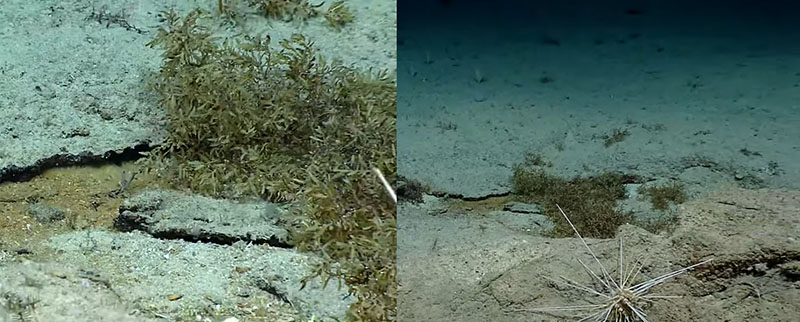Voyage to the Ridge 2022
May 14 - September 2, 2022
What is Sargassum and How Does It Impact Ship Operations?
If you watched (or tried to watch!) any of the dives this past week, you likely heard the word “Sargassum” come up more than once. During our remotely operated vehicle operations in the waters around Puerto Rico, an excess of Sargassum has forced us to move to alternative dive sites as well as to cancel dives altogether. But what is Sargassum, and how can something so unassuming be powerful enough to affect a ship?
What is Sargassum?
Sargassum is a genus of large brown seaweed (a type of algae) that floats in island-like masses, never attaching to the seafloor. It is abundant in the ocean and has leafy appendages, branches, and round, gas-filled structures called pneumatocysts, which are filled mostly with oxygen. Pneumatocysts add buoyancy to the plant structure and allow it to float on the surface.
Floating rafts of Sargassum can stretch for miles across the ocean, providing food, refuge, and breeding grounds for an array of animals such as fish, sea turtles, marine birds, crabs, shrimp, and more. Some animals, like the Sargassum fish (in the frogfish family), live their whole lives exclusively in this habitat. Sargassum also serves as a primary nursery area for a variety of commercially important fishes such as mahi mahi, jacks, and amberjacks. When Sargassum loses its buoyancy, it sinks to the seafloor, providing energy in the form of carbon to fishes and invertebrates in the deep sea, thus serving as a potentially important addition to deep-sea food web.

This summer, record-breaking amounts of Sargassum have been appearing in the Caribbean, as reported earlier this month by the University of South Florida's Optical Oceanography Lab. While Sargassum in this quantity has been disruptive to Voyage to the Ridge 2022 dive operations in the region, it is nevertheless, as noted above, an important part of the ocean ecosystem.
How does Sargassum affect ship operations?
The engines of NOAA Ship Okeanos Explorer are cooled by circulating seawater, which is pulled in from below the vessel and pumped back out after removing some heat from the system. Sargassum, in enough quantities, can clog the intakes and prevent seawater from circulating fast enough to keep the engines from overheating. When the engines overheat, there is a risk they will shut down as a protective measure. While the engines shutting down is not harmful to the ship, when it happens, the ship does lose maneuverability, which can be hazardous for diving remotely operated vehicles (ROVs) that are attached to the vessel. Without precise control of the ship’s position, the ROV may drift to the seafloor or other obstacles. Thus, if there is too much Sargassum in the water, we cannot safely dive.
What are the solutions?
The intakes of Okeanos Explorer are equipped with protective strainers. These strainers collect loose material and prevent it from circulating in the cooling system. Periodically, the ship’s engineers clean the strainers to ensure water can flow through at a rate that efficiently cools the engines. The ship’s engineers have been working tirelessly to keep things operational, but sometimes there is simply too much Sargassum to keep up with. Each morning before conducting a dive, the engineers assess the Sargassum accumulation rate to see if the ship is in a safe position to dive.
Can we anticipate the location of Sargassum in advance?
Sargassum drifting through the ocean isn’t always predictable. Right now, there is simply a lot of Sargassum everywhere in our operational area. Local scientists directed us to the University of South Florida's Optical Oceanography Lab, which tracks Sargassum via satellite, to assess if there are areas we can go to that have less Sargassum; however, we haven’t had much luck finding a predictable distribution pattern. Each day, we try a different dive location that is in line with our community and exploration priorities and hope that the wind and tides have cleared out a bit of a space for us to work in.
So far, operational areas closer to St. Croix have had better conditions.
Additional Resources
- Voyage to the Ridge 2022 web coverage (including images and videos)
- Live video of dives (available through September 1)
Published August 31, 2022